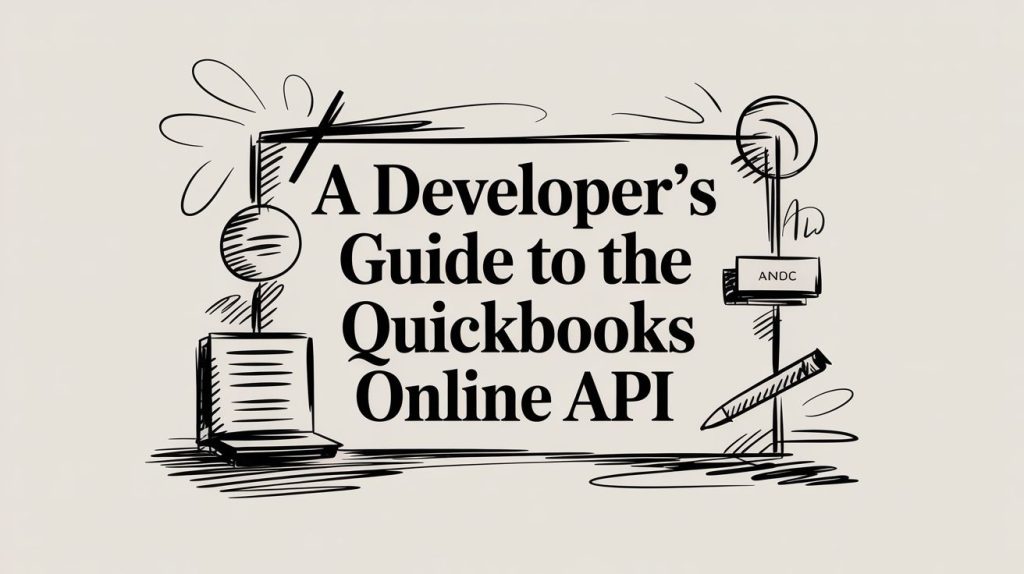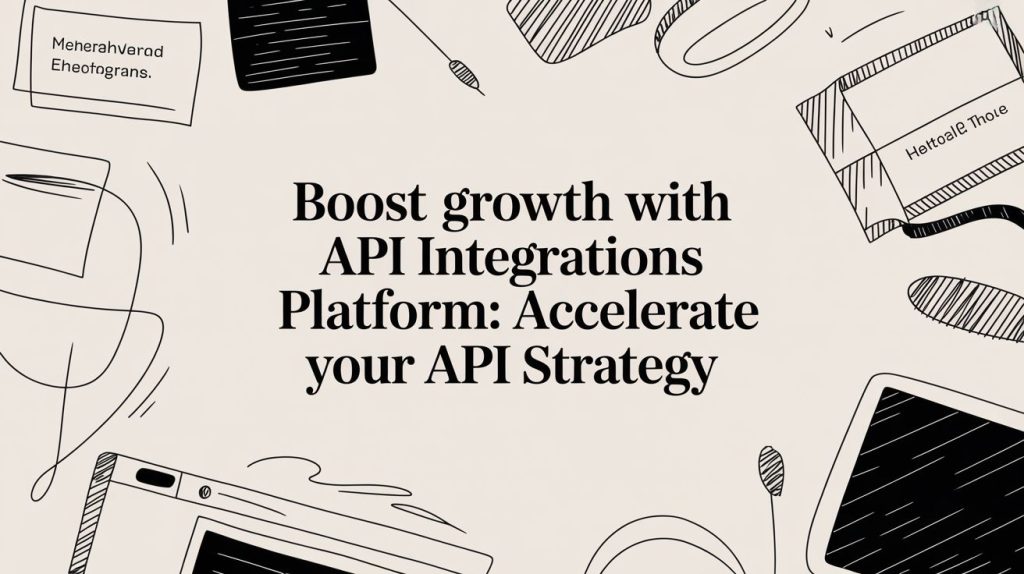
So, what exactly is multi-channel ecommerce integration?
Put simply, it’s the process of connecting all your online sales channels—like a Shopify store, an Amazon storefront, and your social media shops—into a single, intelligent system. The goal is to create one source of truth for your most critical data, like inventory levels, customer orders, and shipping info. This kills manual work and stops expensive mistakes like overselling dead in their tracks.
Decoding Multi-Channel Ecommerce Integration
Imagine your business is a busy airport. Each sales channel—your website, an Amazon listing, a TikTok Shop—is a separate terminal. Without integration, every terminal operates on its own. Your team has to act like frantic gate agents, sprinting from one terminal to another to manually update flight boards (inventory counts) and passenger lists (customer orders). It's chaotic, inefficient, and a recipe for disaster.
Multi-channel ecommerce integration is like building a central control tower for that airport. This system automatically syncs data across every terminal in near real-time. When a product sells on Amazon, its inventory count is instantly updated on Shopify and everywhere else you sell. This automated communication is the heart of integration, turning isolated data silos into a smart, connected network. For a deeper dive into the tech that makes this possible, you can check out our guide on https://api2cart.com/api-technology/what-is-ecommerce-api-integration/.
The Shift From Silos to Synergy
The retail world is spreading out fast. It's predicted that by 2025, the average high-volume seller will be juggling eight or more sales channels—a huge leap from just a few years ago. This explosion of sales points makes manual management a nightmare. In fact, research shows high-volume sellers have a 20% higher demand for connected systems just to keep up. The sudden rise of platforms like TikTok Shop, now used by 29% of top sellers, only adds another layer of complexity for businesses running on spreadsheets.
Moving from siloed operations to a synergistic, unified system isn't a luxury anymore; it's a core business need. It directly solves some of the most persistent headaches for growing online stores:
- It stops overselling for good. By keeping a single, accurate inventory count that updates everywhere, you’ll never have to apologize for selling an item you don't actually have.
- It kills manual data entry. Automation takes over the soul-crushing, error-prone tasks like copying order details or updating stock levels by hand.
- It creates a 360-degree customer view. All customer data from every channel is pulled into one place, giving you a complete picture of their buying habits for smarter marketing and better service.
- It builds a foundation for growth. An integrated system is built to scale. You can add new sales channels without drowning your team in operational chaos.
A truly integrated approach ensures that your brand presents a consistent and reliable face to the customer, no matter where they choose to shop. It’s about creating a seamless experience both for your customers and your internal teams.
To get a quick sense of the difference, here's a look at how daily operations change when you move from a siloed setup to an integrated one.
Siloed vs. Integrated Ecommerce Operations at a Glance
| Operational Area | Siloed (Manual) Approach | Integrated (Automated) Approach |
|---|---|---|
| Inventory Management | Manually updating stock counts on each channel. High risk of overselling. | Central inventory syncs in real-time across all channels. |
| Order Processing | Copy-pasting order details from each platform into a spreadsheet or ERP. | Orders from all channels flow automatically into one centralized system. |
| Customer Data | Customer info is scattered across different channels; no single view. | A unified customer profile is built from all purchase points. |
| Reporting & Analytics | Manually compiling data from multiple sources. Time-consuming and often inaccurate. | Consolidated, real-time reports are generated from a single data source. |
| Adding New Channels | Each new channel adds a significant manual workload and complexity. | New channels are "plugged in" to the existing system with minimal disruption. |
Ultimately, a well-integrated strategy is about more than just connecting software. It's about building an operational backbone that is efficient, accurate, and ready to handle whatever comes next. To see how this concept extends to customer-facing activities, explore this guide on omnichannel marketing integration.
The Strategic Benefits of a Unified System
Tying your sales channels together isn't just a technical tweak—it's a core business strategy. The real prize here is operational excellence. When all your systems are talking to each other, tedious manual tasks like copying order details or updating stock counts disappear, which dramatically slashes the risk of human error.
This automation gets your team out of the weeds. Instead of wasting hours wrestling with inventory spreadsheets, they can zero in on what actually grows the business: killer customer service, smart marketing, and product innovation. The result is a leaner, more effective operation.
Ultimately, one of the biggest wins from integrating your eCommerce channels is the ability to streamline everything you do and figure out how to scale your business effectively.
Eradicate Costly Inventory Errors
The most immediate win you'll see from multi channel ecommerce integration is perfect inventory synchronization. Let's say you have ten units of a best-selling product. Without integration, a sale on Amazon doesn't instantly update your stock levels on Shopify or eBay. This is a recipe for overselling—taking someone's money for an item you don't actually have.
Overselling is a fast track to angry customers, terrible reviews, and even penalties from marketplaces. A unified system becomes the single source of truth for your entire inventory.
When an item sells on one channel, the stock count is immediately and automatically adjusted across every other channel. This proactive management stops stockouts before they happen, safeguarding your brand reputation and keeping customers happy.
Create a Superior Customer Experience
A fragmented setup leads to a choppy, impersonal customer journey. When customer data is siloed across different platforms, you can't see the whole story. Did the person who just bought from your website also buy from your Amazon store last month? Without integration, it's anyone's guess.
A unified system pulls all customer interactions into one clean, complete profile. This 360-degree view is your key to delivering amazing service and personalized marketing that actually works.
- Better Support: Your service team can see a customer's entire order history across all channels, letting them solve problems faster and without frustration.
- Smarter Marketing: With all your data in one place, you can segment customers based on their complete buying behavior, not just a fraction of it. This means your marketing campaigns will be far more relevant and effective.
- Increased Loyalty: Customers feel understood and valued when they have a seamless experience, no matter where they choose to shop. That's how you build real, lasting loyalty.
The boom in omnichannel strategies is directly tied to this elevated experience. Companies that get it right see 89% higher customer retention rates and purchase rates that are a staggering 287% greater than their single-channel counterparts. And with experts predicting that 80% of B2B sales interactions will happen online by 2025, a unified system is no longer a nice-to-have; it's essential for meeting modern customer expectations.
By centralizing your data, you stop just selling products and start building relationships. For a deeper dive into how these connections are made, check out this guide: a guide to multi-channel integration with eCommerce platforms. This connected approach is the bedrock of any modern, customer-first retail business.
Understanding Your Core Data Workflows
At the heart of any solid multi channel ecommerce integration are the data flows that keep your operation alive. Think of your business like a bustling city. Each sales channel—your Shopify store, your Amazon listings, your Walmart presence—is a distinct district, and your integration platform is the central traffic control hub. The data itself is the traffic, and it needs to move constantly between districts to keep the city humming.
Without clear roads and working signals, you get gridlock. Lost shipments. Angry customers. A properly integrated system, on the other hand, builds a smart, efficient traffic network for four essential types of data: orders, inventory, products, and customers. Let's break down how this digital traffic management really works.
The Order Management Superhighway
When a customer places an order on any channel, it’s like a car starting a journey. This order data holds the destination (shipping address), the contents (the products they bought), and payment details. The integration’s first job is to get that car onto the main superhighway and route it directly to your central fulfillment system, whether that's a warehouse management system (WMS) or an ERP.
This automated flow is what stops orders from getting lost in the shuffle or delayed by manual entry. Instead of someone having to check each channel and copy-paste details, the integration grabs the order and sends it straight to be picked, packed, and shipped. Once the package is out the door, the system sends tracking information back to the original sales channel, keeping the customer in the loop and closing the circle.
Real-Time Inventory Broadcasts
Inventory is probably the most critical piece of data to get right in a multi-channel setup. Using our city analogy, inventory data is like a real-time report on parking availability in every district. When a product sells on Amazon, a parking spot is taken. Your integration platform immediately broadcasts this news to every other district, ensuring they all know one less spot is available.
This prevents the classic multi-channel nightmare: selling the same item twice. That instant communication keeps your stock levels accurate everywhere, all the time.
- Stock Updates: When a new shipment arrives, the central hub updates every channel with the new "parking availability."
- Low Stock Alerts: The system can be configured to send alerts when a popular item's inventory drops below a set threshold.
- Returns Management: When an item is returned, its stock count is automatically added back to the available pool across all connected channels.
Consistent Product Information Flow
Product data covers everything from SKUs, descriptions, and pricing to images and technical specs. Inconsistent product information just creates a confusing and untrustworthy brand experience. If a t-shirt is listed for $25 on your website but $30 on eBay, customers are going to pause and question your credibility.
A robust integration creates a "golden record" for each product within your central system. Any changes you make to this master record are automatically pushed out to all your connected sales channels. This guarantees every customer sees the correct price, description, and images, no matter where they found you.
An integrated product data workflow guarantees consistency. It turns a chaotic mess of potentially conflicting information into a single, reliable source of truth that powers your entire retail presence.
The Unified Customer Data Hub
Finally, there’s customer data. Names, contact info, and order histories are often scattered across a dozen different platforms. This fragmentation makes it impossible to get a true picture of your customers. Do your top Amazon buyers also browse your Shopify store? Without integration, you'd never know.
A multi channel ecommerce integration solution pulls all this scattered data into a single, unified customer profile. This central hub gives you a 360-degree view of each customer's entire journey with your brand. Armed with that powerful insight, your marketing and support teams can deliver the kind of personalized experiences that build real loyalty and drive repeat business. Learning how to sync store data across different shopping platforms is the key to creating this holistic view and turning isolated data points into a powerful, cohesive operational engine.
Comparing Integration Architectures and Methods
Knowing your data needs to flow between systems is just the first step. The real trick—what separates a functional setup from a high-performance one—is understanding how it should flow. A multi channel ecommerce integration isn't a one-size-fits-all solution. The technical blueprint, or architecture, you choose will directly shape your system’s scalability, maintenance costs, and ability to handle whatever you throw at it.
Think of it like designing a city's road network. You could build a direct road from every single house to every single office, but you'd end up with an unmanageable, tangled mess. The smart approach is to design an organized system that handles traffic efficiently. That's exactly what a good integration architecture does for your data.
Choosing Your Integration Blueprint
The most basic option is a point-to-point integration. This is like that direct road between two locations—say, your Shopify store and your warehouse management system (WMS). It’s fast and simple for that one connection. But the moment you add more channels, the complexity explodes. Connecting just five systems requires ten individual connections, creating what developers grimly call "spaghetti architecture." It's a nightmare to maintain.
A far more scalable model is the hub-and-spoke architecture. Here, a central integration platform (the hub) connects to each of your channels and systems (the spokes). Instead of systems talking directly to each other, everything communicates through this central hub. This approach completely simplifies management. Adding a new sales channel means building just one connection to the hub, not one to every other system you use. It's clean, organized, and built for growth.
A hub-and-spoke model is like a central traffic controller for your business data. It makes sure information gets where it needs to go without creating a fragile web of direct connections that are bound to break.
How Your Systems Talk: Synchronizing Data
Once you have the blueprint, you need to decide on the communication method—how your systems will actually synchronize data. This choice dictates how quickly your business can react to critical events, like a flood of new orders or a product running low on stock.
Below is a quick comparison of the three most common ways systems stay in sync. Each has its own rhythm and is best suited for different operational needs.
Comparing Data Synchronization Methods
| Method | How It Works | Pros | Cons | Best For |
|---|---|---|---|---|
| Webhooks | Systems send an instant notification (a webhook) the moment an event happens, like a new order being placed. | Real-time updates, highly efficient, low resource usage since it's event-driven. | Can be complex to set up; requires the source system to support webhooks. | Time-sensitive operations like instant order processing and inventory updates to prevent overselling. |
| Scheduled Polling | The integration platform "polls" or asks other systems for updates at regular, set intervals (e.g., every 5 minutes). | Simple to implement, reliable, and works with almost any API. | Can be resource-intensive, as many checks might return no new data. Creates delays between updates. | Less critical data syncs, like updating product descriptions or syncing daily sales reports. |
| Incremental Updates | A smarter version of polling where the system asks only for data that has changed since the last check. | More efficient than full polling, reduces data load, and lowers API call volume. | Still relies on a schedule, so it's not truly real-time. Can be more complex than basic polling. | Regularly updating customer records, syncing order statuses, or pulling new product listings without fetching the entire catalog. |
As you can see, there's a clear trade-off between speed, efficiency, and implementation complexity. Webhooks offer near-instantaneous updates, making them the gold standard for modern eCommerce operations where every second counts.
The rapid growth of global eCommerce makes these choices more critical than ever. With online sales projected to soar to $6.8 trillion by 2025, sellers are getting creative with hybrid fulfillment strategies. Many now combine Fulfillment by Amazon (FBA) with their own fulfillment (FBM) to balance delivery speed and cost. This kind of operational complexity can't run on manual effort; it demands rock-solid automation to sync inventory and orders flawlessly across every channel.
You can dig deeper into how top sellers are preparing for this future by exploring the complete marketplace selling guide on Linnworks.com.
Ultimately, picking the right blend of architecture and synchronization methods ensures your multi-channel integration is more than just a simple connector. It becomes a powerful, future-proof engine that can keep up with your business today and scale with you tomorrow.
Best Practices for a Successful Implementation
A successful multi channel ecommerce integration is built on a foundation of careful planning, not just clever code. If you jump straight into development without a clear roadmap, you're setting yourself up for budget overruns, missed deadlines, and a system that breaks under pressure. Following a few battle-tested best practices helps you navigate the complexities, minimize risk, and build an integration that’s both reliable and ready to grow with you.
The first and most critical step is creating a detailed data map. Think of this as your architectural blueprint. It defines exactly what information needs to move, where it comes from, and where it needs to go. For example, will an order from Amazon flow directly to your WMS, or should it pass through your ERP first? A clear data map prevents a ton of confusion down the road and ensures every piece of data has a designated path.
Plan for Data Transformation and Errors
Once you know where data is headed, you have to plan for how it will be transformed along the way. Your systems almost certainly speak slightly different languages. For instance, your Shopify store might use an SKU format like "TSHIRT-BLU-L," while your warehouse system uses a numerical SKU like "100-200-300." Data transformation is the process of translating these formats so every system understands the information it receives.
Just as important is building robust error handling. No integration is perfect; APIs go down, data gets corrupted, and connections fail. A resilient system anticipates these issues. Instead of crashing, it should have a clear process for logging the error, notifying your team, and automatically retrying the failed action once the connection is restored. This proactive approach ensures minor hiccups don't snowball into major operational disasters.
A well-planned integration doesn’t just work when everything is perfect; it is designed to manage and recover gracefully when things inevitably go wrong. This resilience is the hallmark of a professional, enterprise-grade system.
Avoid Common Implementation Pitfalls
Navigating the technical landscape of integration means being aware of the common traps that can completely derail a project. Being mindful of these pitfalls from the start will save you countless headaches down the road.
This diagram helps visualize a few key integration methods and the different ways data can be synchronized.
As you can see, there's a clear trade-off between real-time updates (Webhooks) and scheduled checks (Polling). This choice directly impacts some of the most common implementation mistakes people make.
Here are a few critical mistakes to avoid at all costs:
- Ignoring API Rate Limits: Every API has rules about how often you can request data. Ignoring these "rate limits" is like spamming a server. The platform will eventually just block your connection, shutting down your data flows and disrupting your entire operation.
- Failing to Plan for Scale: The integration you build today has to handle the order volume you expect in two years. A system that works perfectly fine for 100 orders a day might completely crumble under the pressure of 1,000. Always design for future growth from day one.
- Underestimating Testing: Thorough testing is non-negotiable. This isn’t just about checking if data moves; it’s about simulating real-world scenarios. What happens during a flash sale that generates a massive spike in orders? What if an API from one of your channels goes down for an hour? A lack of rigorous testing almost always leads to critical failures after you go live.
By mapping your data, planning for transformation and errors, and steering clear of these common pitfalls, you position your multi channel ecommerce integration for long-term success.
How to Choose the Right Integration Platform
Picking a third-party integration provider is a big deal, especially when building everything from scratch just isn't an option. Think of it less like buying a piece of software and more like hiring a long-term partner for your most critical operations. The right platform becomes a true extension of your team, giving you the plumbing that connects your software to the entire ecommerce world.
A shaky or unreliable partner will cause you nothing but headaches—from broken data syncs to radio silence from support when you need them most. But a strong partner? They’ll speed up your roadmap and save you a fortune in development costs. The goal is to find a solution that fits your technical skills and your business goals like a glove, making your multi channel ecommerce integration a powerful asset, not a nagging liability.
Evaluating Core Capabilities and Connectivity
The first thing to check is the platform's reach. An integration platform is only as good as the channels it can connect to. You need a provider that covers the big players like Shopify and Amazon but also supports the niche marketplaces and shopping carts your customers are using today—and might use tomorrow.
Look for a provider that offers a unified API. A solution like API2Cart, for example, lets you build a single connection to their API and instantly plug into over 60 different ecommerce platforms. This approach saves hundreds of developer hours that you’d otherwise spend building and maintaining dozens of separate integrations.
Beyond just the number of connections, you have to look at the quality:
- API Reliability and Uptime: Check their status page and what they promise in their service level agreements (SLAs). Consistent uptime isn't a "nice-to-have"; it's non-negotiable.
- API Documentation: Is the documentation clear, thorough, and full of real-world examples? Your developers will be living in it.
- Developer Support: What kind of technical support do they offer? Fast, expert help can be the difference between a quick fix and days of painful downtime.
Assessing Scalability and Future-Proofing
A platform that works for you today could easily crumble under the weight of your future growth. Scalability isn't just about handling more data. It's about partnering with a company that constantly invests in its infrastructure and stays ahead of what’s next in the industry. Let's not forget that a recent survey found 23% of shoppers will ditch their cart if delivery takes too long, which puts massive pressure on fulfillment systems to perform flawlessly.
When selecting an integration partner, you're not just buying a tool for today; you're investing in a foundation for future growth. Ensure their architecture can handle significant increases in API calls, connected stores, and data volume without performance degradation.
This also means you need to look at their roadmap. Are they regularly adding new platform integrations? Are they updating existing ones to support the latest features? A forward-thinking provider makes sure you won't get left behind as the ecommerce landscape changes. Partnering with a platform that grows alongside you is the secret to building a tech stack that’s both resilient and ready for whatever comes next.
Frequently Asked Questions
When you start digging into multi channel ecommerce integration, a lot of practical questions come up. Let's tackle some of the most common ones to give you a clearer picture of what to expect.
How Much Does Integration Typically Cost?
This is the big question, and the honest answer is: it depends. The cost can swing wildly based on what you need. A simple, off-the-shelf connector linking two platforms might just be a few hundred dollars a month. Easy enough.
But if you're talking about a custom, enterprise-level integration—something that ties together multiple complex systems—you could be looking at tens of thousands of dollars in development, plus ongoing costs to keep it all running smoothly.
This is where a unified API platform often hits the sweet spot. It dramatically cuts down the upfront development work compared to building from scratch, but gives you way more power than a basic app. Your final price tag usually comes down to how many systems you're connecting and how much data you're pushing through them.
Can I Use My Existing FBA Inventory?
Yes, absolutely! This is one of the smartest moves you can make. Using your Fulfillment by Amazon (FBA) stock to ship orders from your other channels is a game-changer. It's a strategy called Amazon Multi-Channel Fulfillment (MCF), and a good integration makes it automatic. An order from your Shopify store can be routed directly to an Amazon warehouse without you lifting a finger.
Doing this lets you:
- Consolidate your stock into one big pool. No more stranded inventory sitting in one warehouse while another channel is sold out.
- Leverage Amazon's world-class logistics for fast, reliable shipping on orders from your own website or other marketplaces.
- Simplify your fulfillment by letting Amazon's teams handle the picking, packing, and shipping across multiple sales channels.
How Long Does an Integration Project Take?
Just like cost, the timeline is all over the map. You could get a simple, pre-built connector up and running in an afternoon. On the other end of the spectrum, a complex custom project involving an ERP, a warehouse system, and several marketplaces could take anywhere from three to six months, sometimes even longer.
The biggest things that stretch out the timeline are messy data that needs cleaning up and poor-quality APIs from the systems you're trying to connect. A clear plan and a phased rollout are your best friends for keeping the project on track.
The real key to a manageable timeline is starting with a well-defined scope. Nail down your "must-have" data flows first. Save the "nice-to-haves" for a later phase. This gets your most critical functions live as quickly as possible.
Ready to stop building and maintaining dozens of separate connections? With API2Cart, you can connect your software to over 60 shopping platforms and marketplaces through a single, unified API. Save development time, reduce costs, and accelerate your time-to-market. Start your free trial today.







